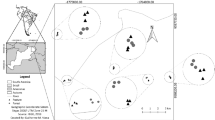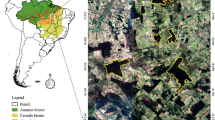Abstract
Oil palm plantations today cover large areas of former tropical lowland rain forest in Southeast Asia and are rapidly expanding on the island of Borneo. Study of the community of ground-dwelling ants in different plantations in Sabah, Malaysia, over 2 years using tuna baiting, revealed that the oil palm plantation ground ant community was severely reduced in species richness in comparison to the forest interior, regardless of age, undergrowth cover, or proximity to neighbouring forest. The results indicate that oil palm plantation habitats, now covering more than 15% of Sabah’s land area, can sustain only about 5% of the ground-dwelling ant species of the forest interior. Nine of the 23 ant species baited in the plantations were never recorded inside forest. All numerically dominant ants were non-forest species. The most common species was Anoplolepis gracilipes, an invasive species present at 70% of all bait sites and known to cause ‘ecological meltdowns’ in other situations. The low frequency and species number of forest ground ants indicates that oil palm plantations act as effective dispersal barriers leading to community isolation in rain forest remnants. The replacement of natural forests with oil palm plantations poses a serious threat to the conservation of biodiversity on Borneo if similar results are confirmed in other taxa.


Similar content being viewed by others
References
Abbott KL, Green PT (2007) Collapse of an ant-scale mutualism in a rainforest on Christmas Island. Oikos 116:1238–1246. doi:10.1111/j.0030-1299.2007.15629.x
Achard F, Eva HD, Stibig H-J, Mayaux P, Callego J, Richards T, Malingreau J-P (2002) Determination of deforestation rates of the world’s humid tropical forests. Science 297:999–1002. doi:10.1126/science.1070656
Agosti D, Majer J, Alonso E, Schultz TR (2000) Ants: standard methods for measuring and monitoring biodiversity. Biological diversity handbook series. Smithsonian Institution Press, Washington DC, 280 pp
Alonso LE (2000) Ants as indicators of diversity. In: Agosti D, Majer J, Alonso E, Schultz TR (eds) Ants: standard methods for measuring and monitoring biodiversity. Biological diversity handbook series. Smithsonian Institution Press, Washington DC, pp 80–88
Bickel TO, Brühl CA, Gadau JR, Hölldobler B, Linsenmair KE (2006) Influence of habitat fragmentation on the genetic variability in leaf litter ant populations in tropical rainforests of Sabah, Borneo. Biodivers Conserv 15:157–175. doi:10.1007/s10531-004-4248-1
Bolton B (1994) Identification guide to the ant genera of the world. Harvard University Press, London, 1689 pp
Bos MM, Tylianakis JM, Steffan-Dewenter I, Tscharntke T (2008) The invasive yellow crazy ant and the decline of forest ant diversity in Indonesian cacao agroforests. Biol Invasions 10:1399–1409. doi:10.1007/s10530-008-9215-4
Brühl CA (2001) Leaf litter ant communities in tropical lowland rain forests in Sabah, Malaysia: effects of forest disturbance and fragmentation. Dissertation, Julius-Maximilians-Universiät, Würzburg, Germany, 168 pp. Available from http://www.opus-bayern.de/uni-wuerzburg/
Brühl CA, Gunslam G, Linsenmair KE (1998) Stratification of ants (Hymenoptera, Formicidae) in a primary rain forest in Sabah, Borneo. J Trop Ecol 14:285–297. doi:10.1017/S0266467498000224
Brühl CA, Maryati M, Linsenmair KE (1999) Altitudinal distribution of leaf litter ants along a transect in primary forests on Mount Kinabalu, Sabah, Malaysia. J Trop Ecol 15:265–277. doi:10.1017/S0266467499000802
Brühl CA, Eltz T, Linsenmair KE (2003) Size does matter—fragmentation of tropical rain forest in Sabah Malaysia and the effects on the leaf litter ant community. Biodivers Conserv 12:1371–1389. doi:10.1023/A:1023621609102
Cao KF (2000) Water relations and gas exchange of tropical saplings during a prolonged drought in a Bornean heath forest, with reference to root architecture. J Trop Ecol 16:101–116. doi:10.1017/S0266467400001292
Carroll CR, Janzen DH (1973) Ecology of foraging by ants. Annu Rev Ecol Syst 4:231–257. doi:10.1146/annurev.es.04.110173.001311
Carter C, Finley W, Fry J, Jackson D, Willis L (2007) Palm oil markets and future supply. Eur J Lipid Sci Technol 109:307–314. doi:10.1002/ejlt.200600256
Carvalho KS, Vasconcelos HL (1999) Forest fragmentation in central Amazonia and its effects on litter-dwelling ants. Biol Conserv 91(2–3):151–157. doi:10.1016/S0006-3207(99)00079-8
Chazdon RL (1998) Tropical forests-log’em or leave’em. Science 281:12–13. doi:10.1126/science.281.5381.1295
Colwell RK (1997) EstimateS: statistical estimation of species richness and shared species from samples. Version 5. http://viceroy.eeb.uconn.edu/esimates
Colwell RK, Coddington JA (1994) Estimating terrestrial biodiversity through extrapolation. Philos Trans R Soc Lond Ser B 345:101–118. doi:10.1098/rstb.1994.0091
Danielsen F, Beukema H, Burgess ND, Parish F, Brühl CA, Donald PF, Murdiyarso D, Phalan B, Reijnders L, Struebig M Fitzherbert EB (2008) Biofuel plantations on forested lands: double Jeopardy for biodiversity and climate. Conserv Biol. doi:10.1111/j.1523-1739.2008.01096.x
Dauber J, Wolters V (2000) Microbial activity and functional diversity in the mounds of three different ant species. Soil Biol Biochem 32:93–99. doi:10.1016/S0038-0717(99)00135-2
Davis NE, O’Dowd DJ, Green PT, Mac Nally R (2008) Effects of an alien ant invasion on abundance, behavior, and reproductive success of endemic island birds. Conserv Biol 22(5):1165–1176. doi:10.1111/j.1523-1739.2008.00984.x
Dennis RA, Mayer J, Applegate G, Chokkalingam U, Colfer CJP, Kurniawan I, Lachowski H, Maus P, Permana RP, Ruchiat Y, Stolle F, Suyanto S, Tomich TP (2005) Fire, people and pixels: linking social science and remote sensing to understand underlying causes and impacts of fires in Indonesia. Hum Ecol 33:465–504. doi:10.1007/s10745-005-5156-z
Donald PF (2004) Biodiversity impacts of some agricultural commodity production systems. Conserv Biol 18:17–38. doi:10.1111/j.1523-1739.2004.01803.x
Drescher J, Blüthgen N, Feldhaar H (2007) Population structure and intraspecific aggression in the invasive ant species Anoplolepis gracilipes in Malaysian Borneo. Mol Ecol 16:1453–1465. doi:10.1111/j.1365-294X.2007.03260.x
FAOSTAT (2007) Online statistical service. FAO, Rome. Available from http://faostat.fao.org/. Accessed January 2008
Fitzherbert EB, Struebig MJ, Morel A, Danielsen F, Brühl CA, Donald PF, Phalan B (2008) How will oil palm expansion affect biodiversity? Trends Ecol Evol 23:538–545. doi:10.1016/j.tree.2008.06.012
Folgarait PJ (1998) Ant biodiversity and its relationship to ecosystem functioning: a review. Biodivers Conserv 7:1221–1224. doi:10.1023/A:1008891901953
Gunadi B, Verhoef HA (1993) The flow of nutrients in a Pinus merkusii forest plantation in Central Java; the contribution of soil animals. Eur J Soil Biol 29:133–139
Hölldobler B, Wilson EO (1990) The ants. Belknap Press of Harvard University Press, Cambridge MA, 733 pp
Jones CG, Lawton JH, Shachak M (1994) Organisms as ecosystem engineers. Oikos 69:373–386. doi:10.2307/3545850
Koh LP, Wilcove DS (2007) Cashing in palm oil for conservation. Nature 448:993–994. doi:10.1038/448993a
Koh LP, Wilcove DS (2008) Is oil palm agriculture really destroying tropical biodiversity? Conserv Lett 1:60–64. doi:10.1111/j.1755-263X.2008.00011.x
Laurance WF, Bierregaard RO (1996) Fragmented tropical forests. Bull Ecol Soc Am 77:34–36
Lawton JH, Bignell DE, Bolton B, Blowmers GF, Eggleton PM (1998) Biodiversity inventories, indicator taxa and effects of habitat modification in tropical rain forest. Nature 391:72–76. doi:10.1038/34166
Lester PJ, Tavite A (2004) Long-legged ants, Anoplolepis gracilipes (Hymenoptera: Formicidae), have invaded Tokelau, changing composition and dynamics of ant and invertebrate communities. Pac Sci 58:391–401. doi:10.1353/psc.2004.0031
MacKinnon K, Hatta G, Halim H, Mangalik A (1996). The ecology of Kalimantan—Indonesian Borneo, Vol. 3. Periplus Editions, Singapore, 802 pp
Majer JD (1993) Comparison of the arboreal ant mosaic in Ghana, Brazil, Papua New Guinea and Australia—its structure and influence on arthropod diversity. In: La Salle J, Gauld ID (eds) Hymenoptera and biodiversity. CAB International, Wallingford, pp 115–141
McMorrow J, Talip M (2001) Decline of forest area in Sabah, Malaysia: relationship to state policies, land code and land capability. Glob Environ Change 11:217–230. doi:10.1016/S0959-3780(00)00059-5
MOPB (2007) Malaysian oil palm statistics 2006, 26th edition. Malaysian Palm Oil Board. Available from http://econ.mpob.gov.my. Accessed June 2008
O’Dowd DJ, Green PT, Lake PS (2003) Invasional ‘meltdown’ on an oceanic island. Ecol Lett 6:812–817. doi:10.1046/j.1461-0248.2003.00512.x
Perfecto I, Vandermeer J (2007) The agricultural matrix and a future paradigm for conservation. Conserv Biol 21:274–277. doi:10.1111/j.1523-1739.2006.00582.x
Pfeiffer M, Ho CT, Teh CL (2008) Exploring arboreal ant community composition and co-occurrence patterns in plantations of oil palm Elaeis guineensis in Borneo and Peninsular Malaysia. Ecography 31:21–32. doi:10.1111/j.2007.0906-7590.05172.x
Schultz TR, McGlynn TP (2000) The interactions of ants with other organisms. In: Agosti D, Majer J, Alonso E, Schultz TR (eds) Ants: standard methods for measuring and monitoring biodiversity. Biological diversity handbook series. Washington DC, Smithsonian Institution Press, pp 35–44
Tilman D, Fargione J, Wolff B, D’Antonio C, Dobson AP, Howarth R, Schindler D, Schlesinger WH, Simberloff D, Swackhammer D (2001) Forecasting agriculturally driven global environmental change. Science 292:281–284. doi:10.1126/science.1057544
Torres JA (1984) Diversity and distribution of ant communities in Puerto Rico. Biotropica 16:296–303. doi:10.2307/2387938
Turner EC, Snaddon JL, Fayle TM, Foster WA (2008) Oil palm research in context: identifying the need for biodiversity assessment. PLoS One 3:e1572. doi:10.1371/journal.pone.0001572
Underwood EC, Fisher BL (2006) The role of ants in conservation monitoring: if, when, and how. Biol Conserv 132(2):166–182. doi:10.1016/j.biocon.2006.03.022
Wetterer JK (2005) Worldwide distribution and potential spread of the long-legged ant, Anoplolepis gracilipes (Hymenoptera: Formicidae). Sociobiology 45:1–21
Wilson EO (2000) Foreword. In: Agosti D, Majer J, Alonso E, Schultz TR (eds) Ants: standard methods for measuring and monitoring biodiversity. Biological diversity handbook series. Smithsonian Institution Press, Washington DC
Yeboua K, Ballo K (2000) Caractéristiques chimiques du sol sous palmeraie. Cahiers d’études et de recherches francophones/Agricultures 9:73–76
Acknowledgments
We want to thank K. Eduard Linsenmair and Brigitte Fiala for discussions of many aspects of this research and Tobias Bickel for his help with tuna baits. We are also thankful to Chey Vun Khen, Arthur Chung, Robert Ong, Hubert Petol and Ruben Nilus of the Forest Research Center in Sandakan for all their support during our stay in Sabah. Permission to conduct research in Sabah was granted by the Economic Planning Unit, the Forestry Department Sabah and the Danum Valley Committee and is gratefully acknowledged. Three anonymous reviewers improved the quality of the paper. This study is project number DV163 of the Danum Valley Rainforest Research and Training Programme and was supported through a DAAD scholarship and DFG travel grant to CAB and by GTZ (TÖB) funding to TE.
Author information
Authors and Affiliations
Corresponding author
Rights and permissions
About this article
Cite this article
Brühl, C.A., Eltz, T. Fuelling the biodiversity crisis: species loss of ground-dwelling forest ants in oil palm plantations in Sabah, Malaysia (Borneo). Biodivers Conserv 19, 519–529 (2010). https://doi.org/10.1007/s10531-009-9596-4
Received:
Accepted:
Published:
Issue Date:
DOI: https://doi.org/10.1007/s10531-009-9596-4




